CHARLES RUSSELL
Page 30

Page 31
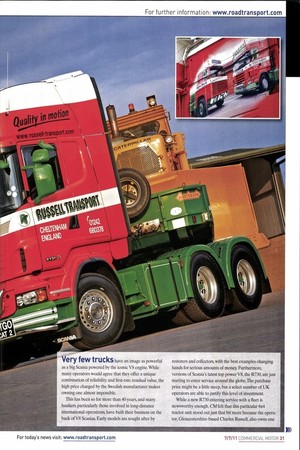
Page 32
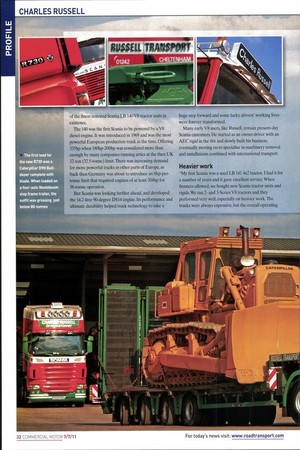
Page 33
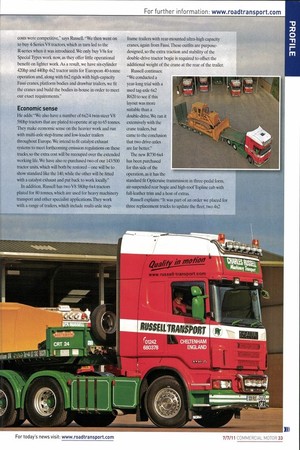
Page 34
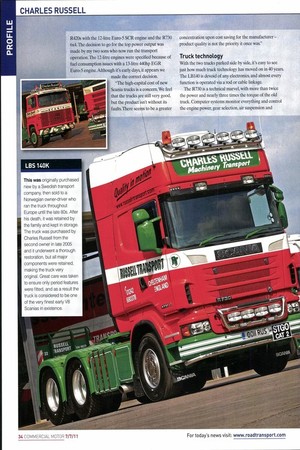
Page 35
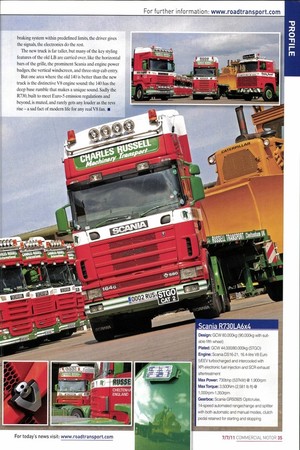
If you've noticed an error in this article please click here to report it so we can fix it.
Words: John Williams / Images: Tom Cunningh:•
CM meets Charles Russell, the Gloucestershire-based haulier who swears by Scania trucks
Very few trucks have an image as powerful as a big Scania powered by the iconic V8 engine. While many operators would agree that they offer a unique combination of reliability and first-rate residual value, the high price charged by the Swedish manufacturer makes owning one almost impossible.
This has been so for more than 40 years, and many hauliers, particularly those involved in long-distance international operations, have built their business on the back of V8 Scanias. Early models are sought after by restorers and collectors, with the best examples changing hands for serious amounts of money. Furthermore, versions of Scania's latest top power V8, the R730, are just starting to enter service around the globe. The purchase price might be a little steep, but a select number of UK operators are able to justify this level of investment.
While a new R730 entering service with a fleet is newsworthy enough, CM felt that this particular 6x4 tractor unit stood out just that bit more because the operator, Gloucestershire-based Charles Russell, also owns one
e finest restored Scania LB 140 V8 tractor units in existence.
The 140 was the first Scania to be powered by a V8 diesel engine. It was introduced in 1969 and was the most powerful European production truck at the time. Offering 335hp when 180hp-200hp was considered more than enough by many companies running artics at the then UK 32-ton (32.5-tonne) limit.There was increasing demand for more powerful trucks in other parts of Europe, as back then Germany was about to introduce an 8hp-pertonne limit that required engines of at least 304hp for 38-tonne operation.
But Scania was looking further ahead, and developed the 14.2-litre 90-degree DS14 engine. Its performance and ultimate durability helped truck technology to take a uge step forward and some lucky drivers' working lives ere forever transformed.
Many early V8 users, like Russell, remain present-day Scania customers. He started as an owner-driver with an AEC rigid in the 60s and slowly built his business, eventually moving on to specialise in machinery removal and installations combined with international transport.
Heavier work "My first Scania was a used LB 141 4x2 tractor. I had it for a number of years and it gave excellent service. When finances allowed, we bought new Scania tractor units and rigids. We ran 2and 3-Series V8 tractors and they performed very well, especially on heavier work. The trucks were always expensive, but the overall operating costs were competitive," says Russell. "We then went on to buy 4-Series V8 tractors, which in turn led to the R-series when it was introduced. We only buy V8s for Special Types work now, as they offer little operational benefit on lighter work. As a result, we have six-cylinder 420hp and 440hp 4x2 tractor units for European 40-tonne operation and, along with 6x2 rigids with high-capacity Fassi cranes, platform bodies and drawbar trailers, we fit the cranes and build the bodies in-house in order to meet our exact requirements."
Economic sense He adds: We also have a number of 6x214 twin-steer V8 580hp tractors that are plated to operate at up to 65 tonnes. They make economic sense on the heavier work and run with multi-axle step-frame and low-loader trailers throughout Europe. We intend to fit catalyst exhaust systems to meet forthcoming emission regulations on these trucks, so the extra cost will be recouped over the extended working life. We have also re-purchased two of our 143/500 tractor units, which will both be restored — one will be to show standard like the 140, while the other will be fitted with a catalyst exhaust and put back to work locally.
In addition, Russell has two V8 580hp 6x4 tractors plated for 80 tonnes, which are used for heavy machinery transport and other specialist applications. They work with a range of trailers, which include multi-axle step frame trailers with rear-mounted ultra-high capacity cranes, again from Fassi. These outfits are purposedesigned, so the extra traction and stability of the double-drive tractor bogie is required to offset the additional weight of the crane at the rear of the trailer.
Russell continues: "We conducted a year-long trial with a used tag-axle 6x2 R620 to see if this layout was more suitable than a double-drive, We ran it extensively with the crane trailers, but came to the conclusion that two drive-axles are far better."
The new R730 6x4 has been purchased for this side of the operation, as it has the standard fit Opticruise transmission in three-pedal form, air-suspended rear bogie and high-roof Topline cab with full-leather trim and a host of extras.
Russell explains: "It was part of an order we placed for three replacement trucks to update the fleet, two 4x2 R420s with the 12-litre Euro-5 SCR engine and the R730 6x4.The decision to go for the top power output was made by my two sons who now run the transport operation. The 12-litre engines were specified because of fuel consumption issues with a 13-litre 440hp EGR Euro-5 engine. Although it's early days, it appears we made the correct decision.
"The high-capital cost of new Scania trucks is a concern. We feel that the trucks re still very good, but the product isn't without its faults. There seems to be a greater concentration upon cost saving for the manufacturer — product quality is not the priority it once was."
Truck technology
With the two trucks parked side by side, it's easy to see just how much truck technology has moved on in 40 years. The LB140 is devoid of any electronics, and almost every function is operated via a rod or cable linkage.
The R730 is a technical marvel, with more than twice the power and nearly three times the torque of the old truck. Computer systems monitor everything and control the engine power, gear selection, air suspension and
braking system within predefined limits, the driver gives the signals, the electronics do the rest.
The new truck is far taller, but many of the key styling features of the old LB are carried over, like the horizontal bars of the grille, the prominent Scania and engine power badges, the vertical windscreen, and three-step cab entry.
But one area where the old 140 is better than the new truck is the distinctive V8 engine sound: the 140 has the deep base rumble that makes a unique sound. Sadly the R730, built to meet Euro-5 emission regulations and beyond, is muted, and rarely gets any louder as the rise — a sad fact of modern life for any real V8 fan.








































































































































